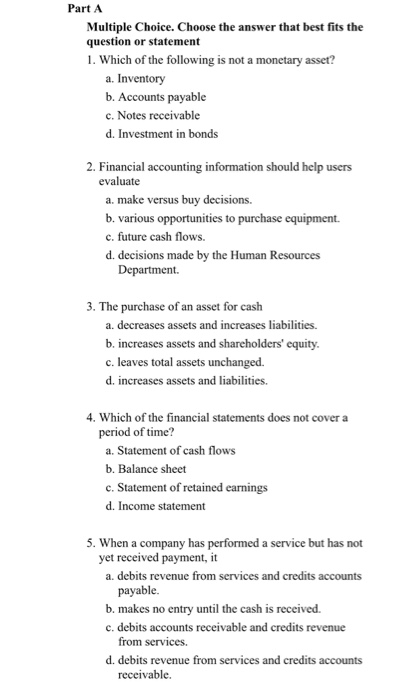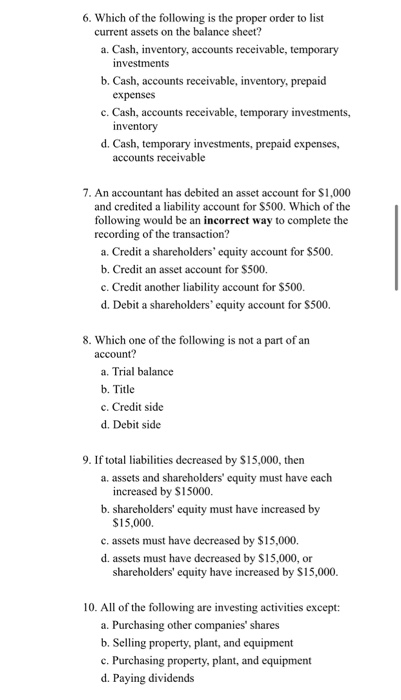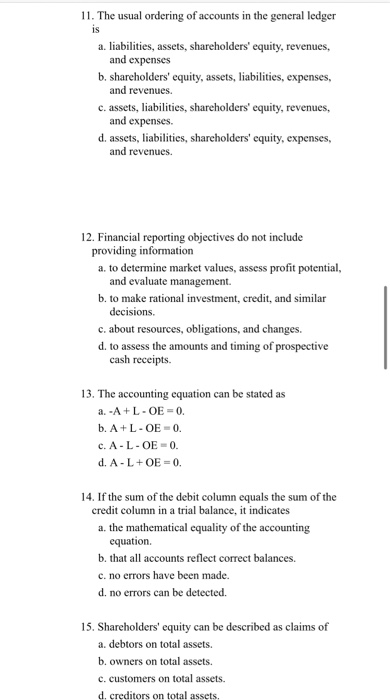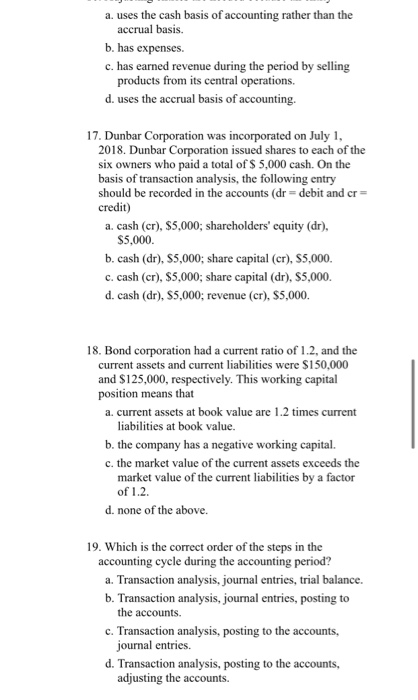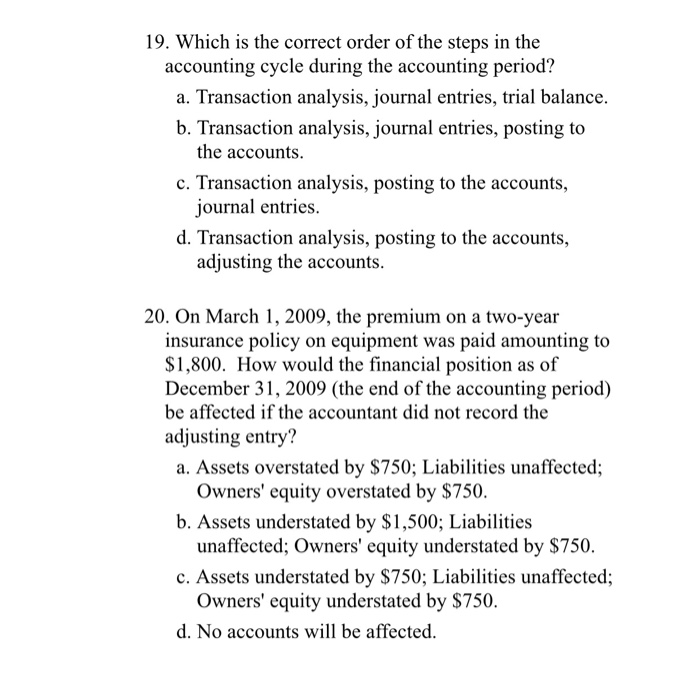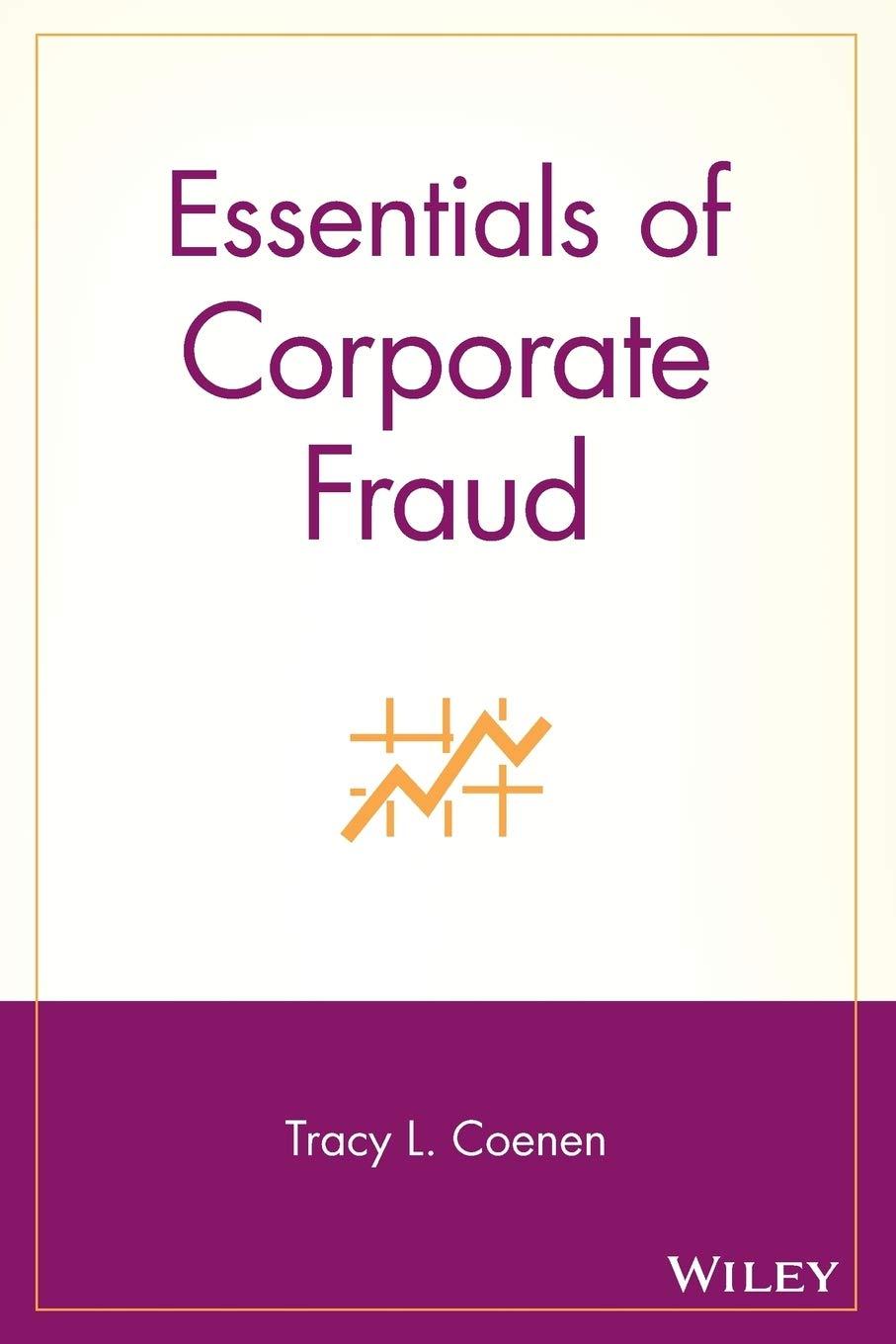Part A Multiple Choice. Choose the answer that best fits the question or statement 1. Which of the following is not a monetary asset? a. Inventory b. Accounts payable c. Notes receivable d. Investment in bonds 2. Financial accounting information should help users evaluate a. make versus buy decisions. b. various opportunities to purchase equipment. c. future cash flows. d. decisions made by the Human Resources Department. 3. The purchase of an asset for cash a. decreases assets and increases liabilities. b. increases assets and shareholders' equity. c. leaves total assets unchanged. d. increases assets and liabilities. 4. Which of the financial statements does not cover a period of time? a. Statement of cash flows b. Balance sheet c. Statement of retained earnings d. Income statement 5. When a company has performed a service but has not yet received payment, it a. debits revenue from services and credits accounts payable b. makes no entry until the cash is received. c. debits accounts receivable and credits revenue from services. d. debits revenue from services and credits accounts receivable. 6. Which of the following is the proper order to list current assets on the balance sheet? a. Cash, inventory, accounts receivable, temporary investments b. Cash, accounts receivable, inventory, prepaid expenses c. Cash, accounts receivable, temporary investments, inventory d. Cash, temporary investments, prepaid expenses, accounts receivable 7. An accountant has debited an asset account for $1,000 and credited a liability account for $500. Which of the following would be an incorrect way to complete the recording of the transaction? a. Credit a shareholders' equity account for $500. b. Credit an asset account for $500. c. Credit another liability account for $500. d. Debit a shareholders' equity account for $500. 8. Which one of the following is not a part of an account? a. Trial balance b. Title c. Credit side d. Debit side 9. If total liabilities decreased by $15,000, then a. assets and shareholders' equity must have each increased by $15000 b. shareholders' equity must have increased by $15,000. c. assets must have decreased by $15,000. d. assets must have decreased by $15,000, or shareholders' equity have increased by $15,000. 10. All of the following are investing activities except: a. Purchasing other companies' shares b. Selling property, plant, and equipment c. Purchasing property, plant, and equipment d. Paying dividends is 11. The usual ordering of accounts in the general ledger a. liabilities, assets, shareholders' equity, revenues, and expenses b. shareholders' equity, assets, liabilities, expenses, and revenues. c. assets, liabilities, shareholders' equity, revenues, and expenses. d. assets, liabilities, shareholders' equity, expenses, and revenues. 12. Financial reporting objectives do not include providing information a. to determine market values, assess profit potential, and evaluate management. b. to make rational investment, credit, and similar decisions. c. about resources, obligations, and changes. d. to assess the amounts and timing of prospective cash receipts. 13. The accounting equation can be stated as a.-A+L-OE = 0. b. A+L-OE-0. c. A-L-OE -0. d. A-L+ OE-0. 14. If the sum of the debit column equals the sum of the credit column in a trial balance, it indicates a, the mathematical equality of the accounting equation. b. that all accounts reflect correct balances. c. no errors have been made. d. no errors can be detected. 15. Shareholders' equity can be described as claims of a. debtors on total assets. b. owners on total assets. c. customers on total assets. d. creditors on total assets. a. uses the cash basis of accounting rather than the accrual basis. b. has expenses. c. has earned revenue during the period by selling products from its central operations. d. uses the accrual basis of accounting. 17. Dunbar Corporation was incorporated on July 1, 2018. Dunbar Corporation issued shares to each of the six owners who paid a total of $ 5,000 cash. On the basis of transaction analysis, the following entry should be recorded in the accounts (dr = debit and cr- credit) a. cash (cr), $5,000; shareholders' cquity (dr), $5,000. b. cash (dr), $5,000; share capital (cr), S5,000. c. cash (cr), $5,000; share capital (dr), $5,000. d. cash (dr), S5,000; revenue (Cr), S5,000. 18. Bond corporation had a current ratio of 1.2, and the current assets and current liabilities were $150,000 and $125,000, respectively. This working capital position means that a current assets at book value are 1.2 times current liabilities at book value. b. the company has a negative working capital. c. the market value of the current assets exceeds the market value of the current liabilities by a factor of 1.2. d. none of the above. 19. Which is the correct order of the steps in the accounting cycle during the accounting period? a. Transaction analysis, journal entries, trial balance. b. Transaction analysis, journal entries, posting to the accounts. c. Transaction analysis, posting to the accounts, journal entries. d. Transaction analysis, posting to the accounts, adjusting the accounts. 19. Which is the correct order of the steps in the accounting cycle during the accounting period? a. Transaction analysis, journal entries, trial balance. b. Transaction analysis, journal entries, posting to the accounts. c. Transaction analysis, posting to the accounts, journal entries. d. Transaction analysis, posting to the accounts, adjusting the accounts. 20. On March 1, 2009, the premium on a two-year insurance policy on equipment was paid amounting to $1,800. How would the financial position as of December 31, 2009 (the end of the accounting period) be affected if the accountant did not record the adjusting entry? a. Assets overstated by $750; Liabilities unaffected; Owners' equity overstated by $750. b. Assets understated by $1,500; Liabilities unaffected; Owners' equity understated by $750. c. Assets understated by $750; Liabilities unaffected; Owners' equity understated by $750. d. No accounts will be affected
